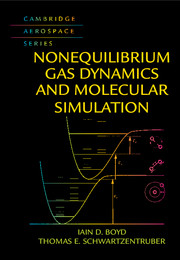Book contents
- Frontmatter
- Contents
- List of Illustrations
- List of Tables
- Preface
- Acknowledgments
- Part I Theory
- Part II Numerical Simulation
- 5 Relations Between Molecular and Continuum Gas Dynamics
- 6 Direct Simulation Monte Carlo
- 7 Models for Nonequilibrium Thermochemistry
- Appendix A Generating Particle Properties
- Appendix B Collisional Quantities
- Appendix C Determining Post-Collision Velocities
- Appendix D Macroscopic Properties
- Appendix E Common Integrals
- References
- Index
7 - Models for Nonequilibrium Thermochemistry
from Part II - Numerical Simulation
Published online by Cambridge University Press: 13 April 2017
- Frontmatter
- Contents
- List of Illustrations
- List of Tables
- Preface
- Acknowledgments
- Part I Theory
- Part II Numerical Simulation
- 5 Relations Between Molecular and Continuum Gas Dynamics
- 6 Direct Simulation Monte Carlo
- 7 Models for Nonequilibrium Thermochemistry
- Appendix A Generating Particle Properties
- Appendix B Collisional Quantities
- Appendix C Determining Post-Collision Velocities
- Appendix D Macroscopic Properties
- Appendix E Common Integrals
- References
- Index
Summary
Introduction
Chapter 6 outlined the Direct Simulation Monte Carlo (DSMC) method, as well as collision cross section models and their link to viscosity, thermal conductivity, and diffusivity. In addition, the general procedure for modeling internal energy transfer and ensuring consistency with continuum modeling was described. In this chapter, more advanced models for rotational and vibrational energy excitation are presented. These models are particularly important for high-temperature gas flows,where the vibrational energies of gas molecules become excited and chemical reactions begin to occur. This chapter describes the most widely used DSMC models for nonequilibrium thermochemistry and also focuses on consistency with continuum models for reacting flows. The DSMC models are formulated using theory from many chapters of the book: kinetic theory, quantum mechanics, statistical thermodynamics, and finite-rate processes. The chapter concludes by presenting DSMC simulation results for high-temperature chemically reacting air.
Rotational Energy Exchange Models
Various models for rotational relaxation have been proposed in the DSMC literature.Almost all widely used models are phenomenological and based on the approach of Borgnakke and Larsen (1975), referred to as the BL model. As described in Chapter 6, if a pair of simulated molecules is chosen for a collision (using the variable hard-sphere [VHS] or variable soft-sphere [VSS] model, for example), the pair is further tested for an inelastic collision, involving energy exchange between the translational and rotational energy modes (εtr and εrot).
The probability used within the DSMC method to perform an inelastic collision was given by Eq. 6.95, and more generally by Eq. 6.110, in conjunction with the selection procedure prohibiting double relaxation depicted schematically in Fig. 6.14. A physical model is required for what this probability should actually be. In general, there are three types of translational-rotational energy exchange models. The first approach uses a constant value for the rotational collision number (Zrot) everywhere in the flow. The second approach models Zrot based on the gas temperature, typically the local cell temperature. In this manner, the value of Zrot (and thus prot) can be different in each DSMC cell, but is constant for all collisions within a cell. Finally, the third approach is to evaluate prot based on the collision quantities of each pair, for example, prot = prot(εtr, εrot). In this section, we present and discuss the most widely used translational-rotational energy exchange models.
Information
- Type
- Chapter
- Information
- Nonequilibrium Gas Dynamics and Molecular Simulation , pp. 252 - 310Publisher: Cambridge University PressPrint publication year: 2017
